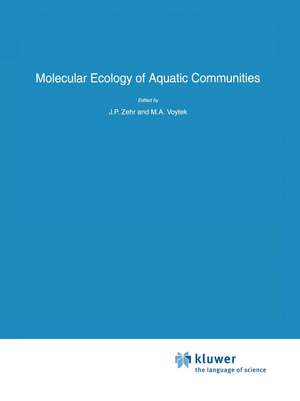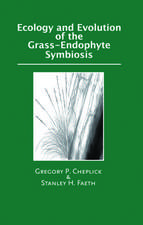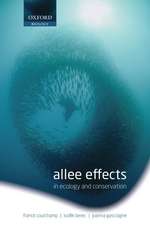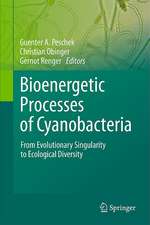Molecular Ecology of Aquatic Communities: Developments in Hydrobiology, cartea 138
Editat de J.P. Zehr, Mary Voyteken Limba Engleză Paperback – 10 oct 2012
| Toate formatele și edițiile | Preț | Express |
|---|---|---|
| Paperback (1) | 1048.34 lei 38-44 zile | |
| SPRINGER NETHERLANDS – 10 oct 2012 | 1048.34 lei 38-44 zile | |
| Hardback (1) | 1067.19 lei 38-44 zile | |
| SPRINGER NETHERLANDS – 30 noi 1999 | 1067.19 lei 38-44 zile |
Din seria Developments in Hydrobiology
- 18%
 Preț: 1229.10 lei
Preț: 1229.10 lei - 18%
 Preț: 959.98 lei
Preț: 959.98 lei - 18%
 Preț: 963.91 lei
Preț: 963.91 lei - 15%
 Preț: 648.24 lei
Preț: 648.24 lei - 15%
 Preț: 637.89 lei
Preț: 637.89 lei -
 Preț: 378.25 lei
Preț: 378.25 lei - 15%
 Preț: 644.95 lei
Preț: 644.95 lei - 18%
 Preț: 952.09 lei
Preț: 952.09 lei - 20%
 Preț: 558.87 lei
Preț: 558.87 lei - 18%
 Preț: 1833.65 lei
Preț: 1833.65 lei -
 Preț: 393.59 lei
Preț: 393.59 lei -
 Preț: 406.54 lei
Preț: 406.54 lei - 18%
 Preț: 1226.73 lei
Preț: 1226.73 lei - 18%
 Preț: 956.99 lei
Preț: 956.99 lei -
 Preț: 388.87 lei
Preț: 388.87 lei - 24%
 Preț: 1060.53 lei
Preț: 1060.53 lei - 18%
 Preț: 1229.28 lei
Preț: 1229.28 lei - 20%
 Preț: 569.31 lei
Preț: 569.31 lei -
 Preț: 368.79 lei
Preț: 368.79 lei - 24%
 Preț: 817.48 lei
Preț: 817.48 lei - 18%
 Preț: 958.25 lei
Preț: 958.25 lei - 18%
 Preț: 953.03 lei
Preț: 953.03 lei -
 Preț: 384.75 lei
Preț: 384.75 lei - 24%
 Preț: 1582.95 lei
Preț: 1582.95 lei - 24%
 Preț: 1051.70 lei
Preț: 1051.70 lei - 18%
 Preț: 943.57 lei
Preț: 943.57 lei - 18%
 Preț: 1235.76 lei
Preț: 1235.76 lei - 24%
 Preț: 800.05 lei
Preț: 800.05 lei - 24%
 Preț: 803.57 lei
Preț: 803.57 lei - 18%
 Preț: 948.29 lei
Preț: 948.29 lei
Preț: 1048.34 lei
Preț vechi: 1379.40 lei
-24% Nou
Puncte Express: 1573
Preț estimativ în valută:
200.66€ • 218.04$ • 168.67£
200.66€ • 218.04$ • 168.67£
Carte tipărită la comandă
Livrare economică 17-23 aprilie
Preluare comenzi: 021 569.72.76
Specificații
ISBN-13: 9789401058278
ISBN-10: 940105827X
Pagini: 292
Ilustrații: VII, 280 p.
Dimensiuni: 195 x 260 x 15 mm
Greutate: 0.62 kg
Ediția:1999
Editura: SPRINGER NETHERLANDS
Colecția Springer
Seria Developments in Hydrobiology
Locul publicării:Dordrecht, Netherlands
ISBN-10: 940105827X
Pagini: 292
Ilustrații: VII, 280 p.
Dimensiuni: 195 x 260 x 15 mm
Greutate: 0.62 kg
Ediția:1999
Editura: SPRINGER NETHERLANDS
Colecția Springer
Seria Developments in Hydrobiology
Locul publicării:Dordrecht, Netherlands
Public țintă
ResearchCuprins
Molecular ecology of aquatic communities: Reflections and future directions.- Plasmid ecology of marine sediment microbial communities.- Use of the polymerase chain reaction and denaturing gradient gel electrophoresis to study diversity in natural virus communities.- Flow cytometry in molecular aquatic ecology.- Distribution of microbial assemblages in the Central Arctic Ocean Basin studied by PCR/DGGE: analysis of a large data set.- Bacterial populations in replicate marine enrichment cultures: assessing variability in abundance using 16S rRNA-based probes.- Diversity of bacterial communities in Adirondack lakes: do species assemblages reflect lake water chemistry?.- New insights on old bacteria: diversity and function of morphologically conspicuous sulfur bacteria in aquatic systems.- The distribution and relative abundance of ammonia-oxidizing bacteria in lakes of the McMurdo Dry Valley, Antarctica.- Microscopic detection of the toluene dioxygenase gene and its expression inside bacterial cells in seawater using prokaryotic in situ PCR.- Variability in bacterial community structure during upwelling in the coastal ocean.- Application of molecular techniques to addressing the role of P as a key effector in marine ecosystems.- Immunological and molecular probes to detect phytoplankton responses to environmental stress in nature.- Spatial scale and the diversity of benthic cyanobacteria and diatoms in a salina.- A rapid method to score plastid haplotypes in red seaweeds and its use in determining parental inheritance of plastids in the red alga Bostrychia (Ceramiales).- Protistan community structure: molecular approaches for answering ecological questions.- Molecular and demographic measures of arsenic stress in Daphnia pulex.- Taxonomic and systematic assessment of planktonic copepods using mitochondrial COI sequence variation and competitive, species-specific PCR.- Ecological implications of molecular biomarkers: assaying sub-lethal stress in the midge Chironomus tentans using heat shock protein 70 (HSP-70) expression.- RNA—DNA ratio and other nucleic acid-based indicators for growth and condition of marine fishes.














